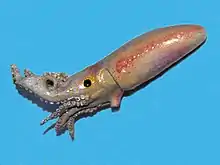| Neorossia caroli | |
|---|---|
 | |
| Museum model of Neorossia caroli | |
| Scientific classification | |
| Domain: | Eukaryota |
| Kingdom: | Animalia |
| Phylum: | Mollusca |
| Class: | Cephalopoda |
| Order: | Sepiida |
| Family: | Sepiolidae |
| Subfamily: | Rossiinae |
| Genus: | Neorossia |
| Species: | N. caroli |
| Binomial name | |
| Neorossia caroli | |
| Synonyms[2] | |
| |
Neorossia caroli, the Carol bobtail squid, is a species of bobtail squid belonging to the family Sepiolidae.[3][4]
Etymology
The species name caroli derives from Carolus, Latinized name of Carlos. It honors H. M. the King don Carlos of Portugal.[5]
Subspecies
Subspecies include:[1]
- N. c. jeannae (southwest Atlantic)
- N. c. caroli (northeast, east, and southeast Atlantic)
Distribution and habitat
This species is widespread in the Atlantic Ocean from Iceland and the United Kingdom southwards along the Atlantic coast of Europe and Africa as far south as Namibia, the Patagonian slope, and Falkland Islands. It is also present in the Mediterranean and Black Seas. This bottom-living species occurs in areas of muddy substrate at depths of 40 to 1744 m.[1][6]
Description
N. caroli can reach a mantle length of 51 mm in males, while in females, the mantle length can attain 83 mm.[7][8] Its body is soft and fleshy, and the mantle is broad and oval. The dorsal border of the mantle is not fused to the head. Arms have two rows of suckers. The ink sac is not functional.[9][10][11]
Biology
These squids usually bury in muddy substrate during the day, emerging only at night to feed. During copulation, the male inserts the arm (hectocotylus) specialized to store and transfer spermatophores into the female's mantle cavity. Spawning occurs throughout the year. The eggs are violet and rather large. They are attached to hard substrates. Males and females usually die after spawning and brooding.[1][6][12]
References
- 1 2 3 4 Barratt, I.; Allcock, L. (2012). "Neorossia caroli". The IUCN Red List of Threatened Species. 2012: e.T162663A939433. doi:10.2305/IUCN.UK.2012-1.RLTS.T162663A939433.en. Downloaded on 10 February 2018.
- 1 2 Julian Finn (2016). "Neorossia caroli (Joubin, 1902)". World Register of Marine Species. Flanders Marine Institute. Retrieved 10 February 2018.
- ↑ Catalogue of life
- ↑ ITIS
- ↑ Giambattista Bello The original descriptions of the Mediterranean taxa in the order Sepiolida (Mollusca: Cephalopoda) with notes on the validity of the specific name Sepiola rondeletii Leach, 1817
- 1 2 Sea Life
- ↑ Jereb, P. (2005). An annotated an illustrated catalogue of cephalopod species known to date. Volume 1: Chambered nautilusses and sepioids (Nautilidae, Sepiidae, Sepiolidae, Sepiadariidae, Idiosepiidae and Spirulidae). FAO Species Catalogue for Fishery Purposes 4(1).
- ↑ WoRMS
- ↑ Giovanni Nikiforos Fauna del Mediterraneo
- ↑ Núria Zaragoza, Antoni Quetglas, and Ana Moreno Identification guide for cephalopod paralarvae from the Mediterranean Sea
- ↑ Cephalopods of the World
- ↑ Danila Cuccu, Marco Mereu, Pamela Masala, Angelo Cau and Patrizia Jere Male reproductive system inNeorossia caroli (Joubin 1902) (Cephalopoda: Sepiolidae) from Sardinian waters (western Mediterranean Sea) with particular reference to sexual products
Further reading
- Belloc, G. - Catalogue des types de Cephalopodes du Musee Oceanographique de Monaco -
- Boletzky, S. V. - Neorossia n.g. pro Rossia (Allorossia) caroli Joubin, 1902, with remarks on the generic status of Semirossia Steenstrup, 1887 (Mollusca: Cephalopoda) -
- Joubin, L. - Observations sur divers Cephalopodes. Sixieme note: Sur une nouvelle espece du genre Rossia - Bulletin de la Société Zoologique de France, 27
- Sweeney, M. J. and C. F. E. Roper / N. A. Voss, M. Vecchione, R. B. Toll and M. J. Sweeney - Classification, type localities and type repositories of recent Cephalopoda - Systematics and Biogeography of Cephalopods. Smithsonian Contributions to Zoology, 586 (I-II)
